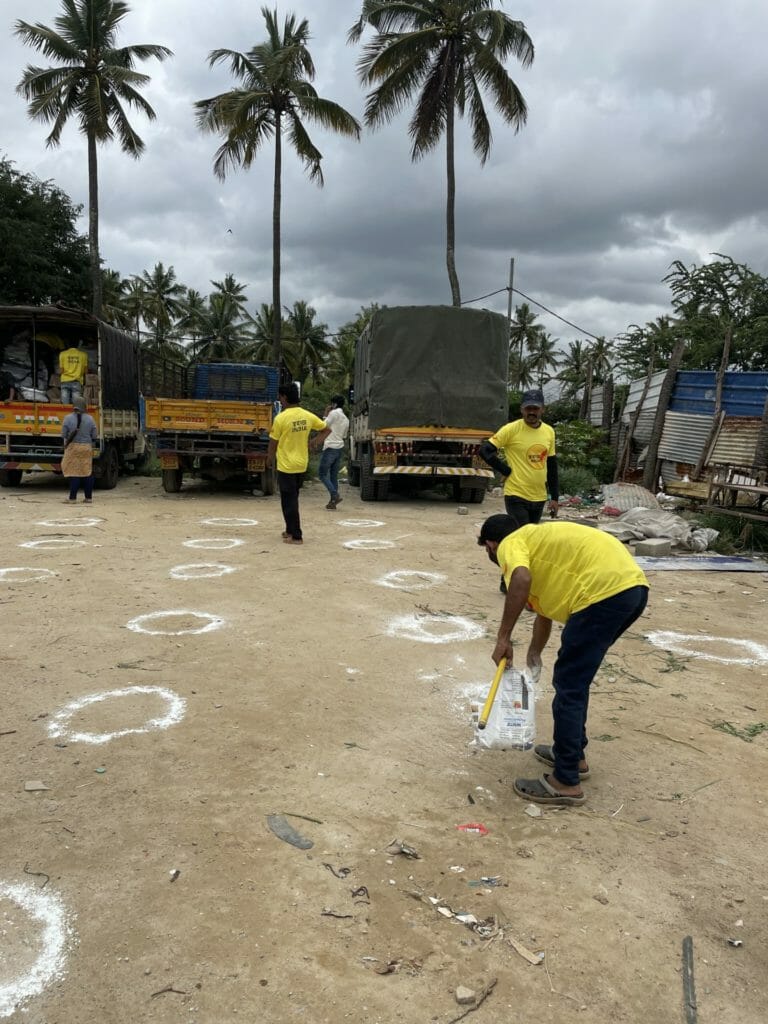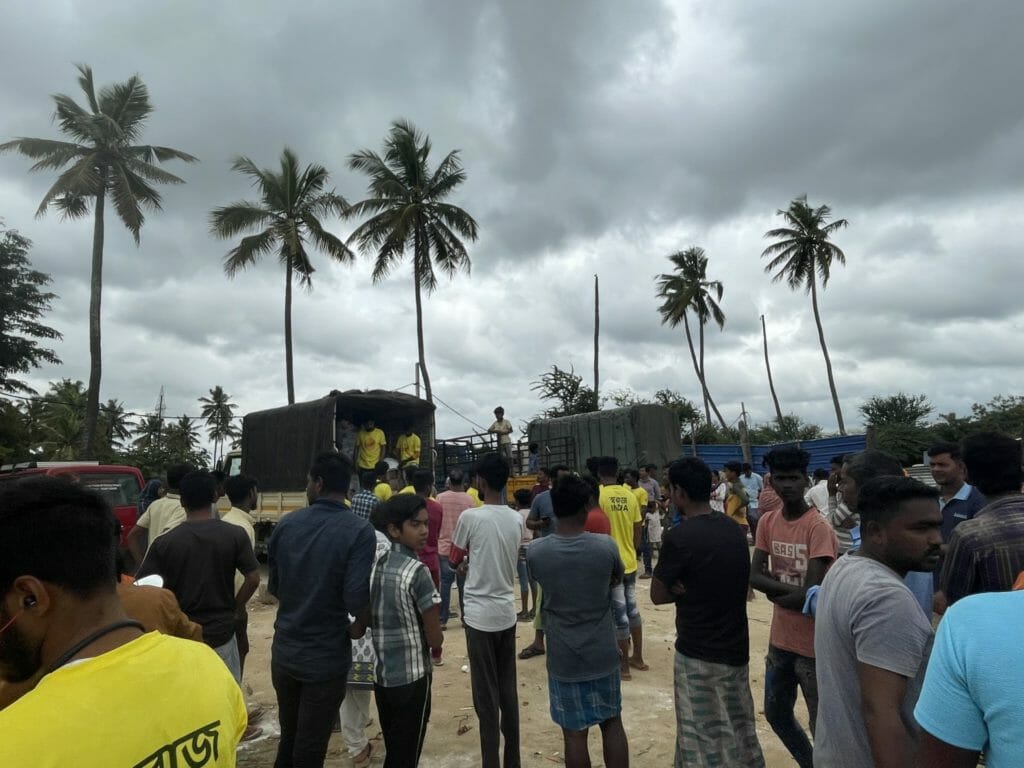Within the narrow lanes of Thubarahalli, garbage dumps on one side and tin shacks on the other, a thumping noise is heard. Two trucks make their way into this neighbourhood. About 30 volunteers in yellow shirts, ‘India’ written on them, follow the trucks in cars and vans. After the trucks are parked, people quickly start assembling near the vehicles. They stand in lines and spots demarcated by the volunteers for better organisation. The trucks have brought packaged food items, which is some relief for the families whose lives have been disrupted by the floods. One by one, queues of people start moving towards the trucks as relief kits are distributed.

The above scenario depicts the relief efforts at Thubarahalli and Munnekollal in Whitefield, in Bengaluru, where heavy rains have inundated several homes.
The distribution programme was facilitated by a number of relief organisations, along with independent civil society donations. The key organisations that arranged the relief distribution were Links Charitable Trust, which oversaw the distribution, and some team members from NGO Swabhimaan who helped with logistics. Through collective efforts, the blockage of basic services was addressed by a renewed flow of goods for the subsistence of the families.
How the rains affected Bengaluru’s migrant workers
Since June 1st Bengaluru has received more than 900 mm of rain, disrupting the city’s infrastructure and mobility. The rains have disproportionately impacted the lives of the people in informal settlements like these. Entire neighbourhoods built of tin shacks have become uninhabitable due to water filling up the interiors.
The rains have created severe constraints in the lives of Bengaluru’s migrant workers, who are already badly hit due to COVID-19 and related issues of unemployment, as well as by the high living costs of the city. Government-based support is minimal for those who are ill and in need of medical services. There was at least one person from the community who passed away due to mobility constraints because of the rains, despite the hospital being only a few kilometres away from the area.
Read more: Homeless and penniless, families of Brookefield settlement blame adjacent tech park for flooding
Inadequate food supply is another issue of concern. While several homes have gas connections, residents reported that most homes have not been cooking. This has been attributed to reduction in ration supply due to the rains, with residents finding it difficult to access ration shops amidst the deluge. Another issue is the condition within homes, with leaking roofs and flooded rooms, cooking has become a challenge. Generally, urban slums tend to have basic services such as gas and electricity connections, but the rains have disrupted all kinds of supplies, including civic amenities.

Not all lives mattered
There have been mixed reactions with regard to relief. Some people reported that BBMP did pump out water from some areas. However, just walking in the settlements is enough to show how water has disrupted the area.
The disappointment over political accountability was also apparent. No MLA or MP has visited the area despite constant reportage about the rains and its impact on the area. Even when the state government did wake up to the crisis, it was only for a certain class of society.
The minister of IT-BT, CN Ashwath Narayan, held a meeting with the chiefs of IT companies, which are located in Whitefield, to assure them of a permanent solution to this menace. The meeting, attended by representatives of Goldman Sachs, Accenture and Amazon, among others, had little to do with these settlements. In fact, there have been reports of BBMP ordering the demolition of temporary structures built by communities rendered homeless by the rains, as part of its ‘anti-encroachment’ drive to clear water flows.
Such attitudes of the authorities have led to the community giving up all expectations of any aid. Most of the people I interacted with, at the relief distribution, were more surprised than relieved by the possibility of anyone helping them out.
The community was differentially affected
Most of the population in the settlement is comprised of migrant workers from Bihar and Bengal. Prabhu, one of the locals and also a volunteer in the relief work, explains the house distribution here. He says there are two different sets of houses in the area: Cemented or pakka houses, with a rent of Rs. 5,000, and tin shacks, with a rent of Rs 2,000. Bijli-paani (water and electricity connection) is charged over and above the rent, by the thekedar (contractor).
The pakka houses, built on higher ground, are somewhat safe from the water, while the tin shacks are uninhabitable. One is reminded that poverty includes many things. One of its chief characteristics being the unequal nature in which it affects an area. Even in a seemingly homogenous income group, people have been differentially affected.

A migrant worker from Odisha says he has been working in Bengaluru for 10 years. His family still lives in his native village. He doesn’t earn much in the city, making roughly Rs 10,000, from which he also has to pay rent for the room, (a cement house), which is sharing accommodation. There are others who have a better hold in the city, who avail more resources.
Another man in his early 50s said his wife works as a maid in one of Whitefield’s housing societies. Her employer allowed her and the family to stay at their place till the rains subside. With no work and his children’s schools shut, the man had temporarily moved the family to his wife’s employer’s apartment. This difference in privilege teaches us that people are not affected equally by the same issue.
The need for streamlining relief distribution processes
Any credible intervention that seeks to help the poor must account for this and work towards rehabilitating the impacted, accordingly. The severely affected, who lack the resources to help themselves, must be rescued first since they are the most vulnerable.
This principle, however, is somehow muddled during the relief distribution. As the crowd swells and the heat peaks at noon, chaos is seen at the distribution line. The mechanism followed is simple, people were given tokens in their houses and are supposed to produce the same at the line to get the relief kit. In some areas with many households, the thekedar, i.e. the contractor, has been given the token according to the number of people living under him. Some people who have waited in line for hours object to this method.
A young man, who claims to have come from the most affected part of the area, says that people most deserving did not get the relief kit for two reasons, either they did not have a contractor who could mediate on their behalf or their share was taken by others. Small fights break out, there is some aggression given the waiting time and the apparent bypassing of the line by some residents. Some take their kits quietly and leave. Some produce several tokens and take as many kits as possible, while others look on.
Read more: Migrant workers — unaware and unable to access state healthcare schemes
While self-organising efforts are useful and, above all, a hopeful means of getting relief, they also pose a grave management problem that needs refining. Reaching the most affected communities is a challenge for the state as well as civil society organisations. Streamlining the relief distribution process will broaden the scope of such organisations and help them seek more accountability from the state.

Hope amid despair
People, however, respond to crises differently. Despair is not the only emotion affected communities experience. Even in the midst of the infrastructural crisis, people felt hope. There were many cheerful people at the distribution centre. They talked about their plight, but also laughed and cheered at whatever was provided to them, hoping for brighter days ahead.
Also read:
- Disaster management in Bengaluru: Temporary fixes touted as solutions as city floods again
- Cities must focus on disaster resilient infrastructure in the era of climate change
- Migrant workers deal with unhygienic living conditions, poor nutrition
- Without documents, most migrant workers’ children find access to education elusive